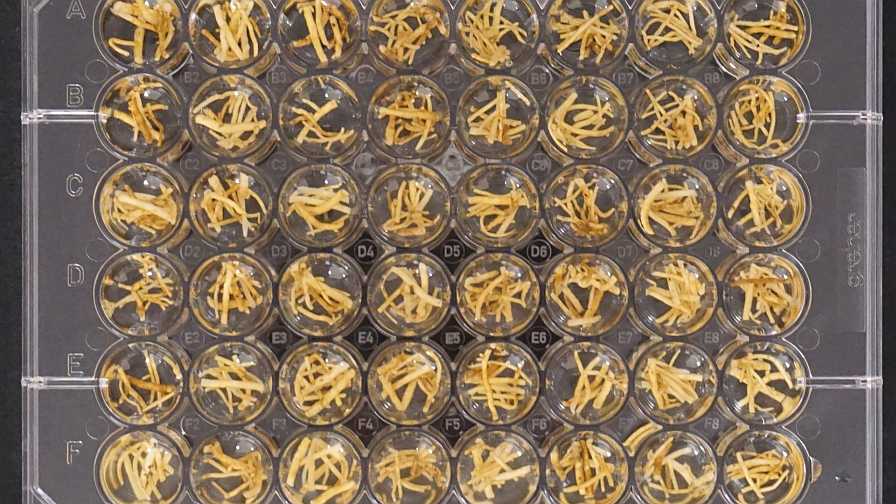‘Hairy Roots’ To the Rescue! Deadly Plant Diseases Put on Notice

This CLas-citrus ‘hairy root’ assay plate might look like a hot mess, but the science behind the experiment could help put a stop to the deadly plant pathogen.
Photo courtesy of Texas A&M AgriLife
Fastidious plant pathogens like HLB, Pierce’s Disease, and zebra chip take a huge bite out of specialty crop markets every year. Researchers at Texas A&M, however, have made a recent discovery that will help combat these devastating diseases and more.
For the past few years, Kranthi Mandadi, a Texas A&M AgriLife Research scientist and Associate Professor in Texas A&M’s Department of Plant Pathology and Microbiology, along with his colleagues, has been working on developing new biological technologies to fight fastidious or “unculturable” pathogens.
The results of their work, “Plant hairy roots enable high throughput identification of new antimicrobials against Candidatus Liberibacter spp.” were recently published in Nature Communications.
The breakthrough came in the form of the “hairy root” system. This technology utilizes the pathogen-infected host tissues to produce so-called hairy roots that can serve as biological vessels for the propagation of these pathogens in the laboratory.
“Classical microbiological techniques developed early in the 19th century cultured animal and mammalian viruses in host cells, tissues and embryonated eggs,” Mandadi said. “In a similar manner, we hypothesized that plant hairy roots could be suitable for propagating fastidious pathogens. And indeed, hairy roots supported the accumulation and growth of fastidious plant bacteria.”
Microbial hairy roots appear similar to normal root tissues that develop from the plant and mimic a bacterium’s natural environment, he said. This allows the growth of the fastidious pathogens in controlled laboratory conditions.
While microbial hairy root cultures are not traditional “pure” test tube cultures, they allow on-demand access to the fastidious bacterium in the laboratory. This enables the expedited screening of diverse antimicrobials like chemical inhibitors, immune modulators, as well as gene/CRISPR-based therapies.
In addition, the hairy root bioassays are scalable, so they can be used to pre-screen from a few to several hundred potential therapies simultaneously in a high-throughput manner. The microbial hairy root system can also be used to obtain mechanistic insights into antimicrobial function.
“Use of this technique has already led to the discovery of six new antimicrobial peptides with proven efficacy in plant materials,” Mandadi said. “These antimicrobials, either singly or in combination, could be used as near- and long-term therapies to control citrus greening, potato zebra chip, and tomato vein greening diseases.”
Mandadi recently partnered on a new project with Citrus Research and Development Foundation, Bayer, Southern Gardens Citrus, University of Florida, and University of California-Davis. That project is funded by USDA’s-NIFA Emergency Citrus Disease Research and Extension program. The overall goal is to bring together academics, growers and agrochemical industry to discover, develop and commercialize therapies for citrus greening disease.
To learn more about Mandadi’s work, continue reading at https://agrilife.org/mandadilab.









